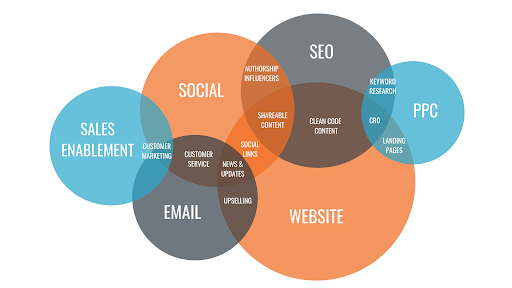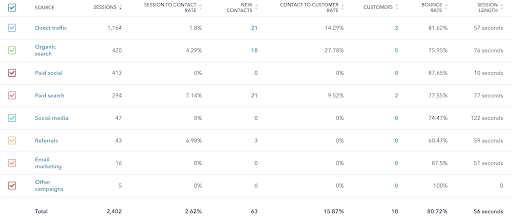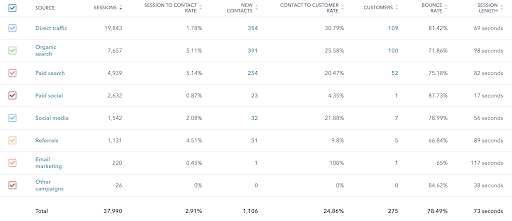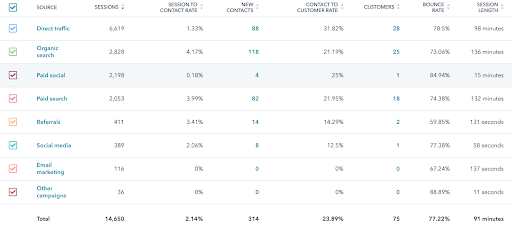Contents
Creating a digital marketing strategy is not a one-time event. The process requires constant refinement to keep it aligned with the goals of your business.
Sometimes the results we are getting are due to factors that may not be obvious at first sight. That’s why it helps to look at elements in our overall digital marketing strategy because each one plays off the other to produce the final result.
This guide is going to help you conduct a top-to-bottom evaluation of your digital marketing strategy. It will help you look at details while evaluating the big picture, so you can make the changes required to improve results and get a better return on your marketing investment.
What Is a Digital Marketing Strategy?
Let’s first define what a digital marketing strategy actually is, because it’s far more involved than throwing money at a paid ad campaign or engaging on social media.
A digital marketing strategy is an overall plan that drives your business towards achieving specific digital goals through the use of various channels that include:
- Paid advertising: Google Ads, social media advertising
- Organic traffic to your website
- Owned media on your site and on other networks that drives traffic to your site
All these channels should have their own separate (but coordinated) campaigns for the purpose of achieving specific, measurable goals.
How is a digital marketing strategy different from a digital marketing campaign?
A digital marketing campaign is one of several components or building blocks of an overall digital marketing strategy. While this may seem overwhelming at first, some businesses can start with a single campaign (such as paid ads on Facebook) to test the waters before formulating a full digital marketing strategy.
Elements of a Digital Marketing Strategy
Digital marketing planning has many components. The time it takes to put a strategy together depends on many factors that can include:
- Business goals
- Resources available to invest
- Number of people on the team
- How much market research needs to be conducted
At BridgeRev, our proprietary internal process can turn around a digital marketing strategy in about 6-8 weeks when 4-8 people are on board.
The important elements we look at are as follows:
Strategic Initiatives
A digital strategy falls under the umbrella of overall marketing, which means that it needs to be tied to specific strategic initiatives. Experience has taught me that 3-4 per year is an ideal number - too few may not make a substantial difference, while too many may cause us to lose focus in the long term.
Some examples of important strategic initiatives include:
- Increase market penetration (ie. gain more customers, generate leads)
- Expand into a new market(s)
- Increase customer retention
- Build brand awareness & reputation
- Increase search engine ranking
Strategic initiatives are important because they help us keep focus. If someone comes to me with a social media post idea or a campaign idea, I first ask “What strategic initiative does that support?”
We never let good ideas go to waste, so any that don’t fit into our current set of initiatives are usually added to a “parking lot” sheet of marketing activities that we can refer back to later.
Goals & KPIs
Strategic initiatives are achieved through goals, and each goal is measured by one or more key performance indicators (KPIs).
Here’s a quick example of how goals and KPIs are tied together:
|
Goals |
KPIs |
|
|
|
|
This is just a tiny sample of what can be measured. There are literally hundreds of KPIs associated with various digital marketing goals so team members directly involved with achieving those goals can usually provide valuable input in determining KPIs.
Buyer Personas
Marketing pros often talk about “target markets” and “audiences”. While these are important concepts, I prefer to use “buyer personas” because they go a big step further in understanding the psychology of clients.
Traditional vs. “Disruptive” Marketing
Traditional marketing finds a target market for a product or service while disruptive online marketing zeros in on the ideal customer and tailors the content marketing to that specific type of buyer.
The big difference can be illustrated by comparing door-to-door sales with what we call “inbound marketing”.
Before the internet, salespeople used to go knocking on doors to sell products hoping that someone was looking for what they were offering. Digital marketers today use inbound marketing techniques to reel in buyers while they are searching for products and services online.
Get into consumer psychology
Psychology is central to effective marketing (along with other areas of life). As a big fan of crime drama, I got drawn into a Netflix show called Mindhunter because it really gets into the psychology of the human mind.
I remember clearly getting hooked from the first or second episode when Holden, the main character, was giving a presentation on new criminology theories to a room full of police officers. The pivotal moment for me was when he put up a slide that read:
WHAT + WHY = WHO
Since psychology is my thing, I had to pause for a minute to process this equation in the context of the marketing landscape my brain lives in.
The lesson was profound. I realized that the “what” is not your product - it’s your ideal customer’s desired outcome and that the “why” is their primary motivation.
To be effective your digital marketing strategy needs to tap into that.
We take buyer personas to another level
HubSpot says buyer personas represent your ideal customer(s) and can be created by researching, surveying, and interviewing your business's target audience.
At BridgeRev, we take buyer personas to a whole new level.
Our profiles include a plethora of demographic and psychographic information that includes:
- Age group
- Location
- How many kids they have
- Relationship status
- Preferred social media network(s)
- Hashtags they use
- Who they follow on social networks
- What websites and blogs they read
Diversity among people is increasing all the time, and that’s why we drill down as many defining characteristics as possible. Since people can be complex, we don't make the mistake of grouping them by title/job role or employment status - because people aren’t defined by their jobs!
Go deep by finding out what motivates your ideal customer
Whenever we kickoff an agreement with a new client I immediately start teaching them to think like their customers. Once we get into buyer personas I encourage them to view their customers by what motivates them.
As I mentioned earlier, Holden on Mindhunter summed it up with one mathematical expression and I’ve now added this to our new client kickoff slides:
WHAT + WHY = WHO
Again, the “what” is not your products and services - it’s your buyer persona’s desired outcome, and the “why” is their primary motivation.
Your digital marketing strategy needs to tap into how your products and services can fill that gap.
Campaign Concepts & Briefs
I’m a strategist at heart. One of my core challenges is to give our content developers everything they need to work toward a goal without any constraints on their thought process, conceptualization, or creativity.
Since campaigns take time to develop, I recommend starting with a campaign planning sheet that includes:
- Strategic initiatives
- Goals
- KPIs
- Proposed timeline
- 2-3 key communication points
Our content team at BridgeRev then takes these points and turns them into campaigns that include:
- Target keyword lists
- Word banks
- Funnel question mapping
- Content maps (blog posts, articles, videos, etc.)
- Messaging
- Visual standards
- Tone, feel & brand
All this is then packaged into a set of briefs that propels our process forward.
Fundamental Assumptions
It’s important to evaluate any assumptions you might have about your ideal customers as they navigate the path from being a lead to becoming a customer. Frameworks are fundamental to laying down a system that can form the basis of your strategy.
Choosing a Framework
There are many to choose from that include the marketing funnel, sales funnel, RACE planning framework, flywheel, and the buyer’s journey. Each one is different and can be adapted to suit the goals of your business.
The Agile Assumption
Nothing is a given when it comes to marketing, so it pays to stay agile so you can pivot when needed to adapt to new conditions. While all the frameworks above have their strong points, it’s very important to stay agile and remain flexible when elements need to be changed.
That’s just one of the reasons our digital marketing strategies at BridgeRev have been so successful.
We monitor the progress we make towards achieving our goals on a weekly basis using KPIs. These are then evaluated or changed on a monthly or quarterly basis as necessary.
There’s no “set it and forget it” mentality here - our sales team can relate how that attitude has negatively affected many businesses who didn’t realize the error until after their market share had dwindled.
How To Measure Your Digital Marketing Plan’s Progress & Success
Measuring is vitally important to track the progress of your digital marketing plan towards achieving the goals of your business. Here are some key steps to take to make sure you are on track:
1. Gather your data
Knowing numbers in real time is one of the keys to staying agile. We use Databox to aggregate the data and view all our KPIs in one place. Other tools include Google DataStudio, Google Analytics, Tableau, or DashThis.
Whatever tool you use, your data visualization efforts should be organized so you can see how they work together as well as how they work in isolation.

As you can see from the above illustration, all the elements of our strategy have some dependency on each other. While some work well in isolation, the combined efforts of all of them have a much greater effect than if each were used separately.
2. Set Your Check-In Frequency
We recommend looking at your KPIs every week and making changes at either monthly or quarterly intervals. Some questions to ask include:
- Are my KPIs tracking up or down?
- Have we done anything in the last 30 days that directly affect any of the KPIs?
We then record our findings and proceed until the monthly team meeting where we review the weekly KPIs, along with month-over-month and year-over-year results. The latter two especially help to account for any seasonal trends in the business.
We then discuss our capacity and agility to make changes. Capacity refers to what the team is able to do in a specific time period while agility refers to the team’s ability to pivot direction.
This can be challenging because making too many adjustments won’t tell us exactly what worked when the time comes to re-evaluate. Instead, we prefer to determine what our priorities are and focus on making precise changes. That allows us to leave the rest for the quarterly check-in where we focus on any bigger changes that take longer to implement.
3. Prioritize Your Changes
Prioritizing changes is challenging. That’s why we focus on 3 levers at a time, which includes:
- The strongest performing (the most efficient)
- The weakest (the least efficient)
- One to test/experiment with
The following case study demonstrates this process in action.
Case Study: HubSpot Traffic
This is a HubSpot traffic report for one month.

As far as case studies go, it’s a good choice because the entire marketing and sales process is happening in one portal. That makes it easy to track our efforts from the initial session all the way to conversion.
Based on this monthly report, we can see that Direct Traffic and Organic Search were our top performers because they converted the most customers.
Unfortunately, this is only a snapshot that doesn’t show customers that took longer than a month to convert.
So we ran that same report for the previous 11 months to see if similar trends held:

This year-to-date picture confirms that Direct Traffic and Organic Search converted website sessions to customers at the highest rate because the same trends held.
From these reports, we confirmed that Direct Traffic and Organic Search are our most efficient channels, while Paid Social was the least efficient channel.
We then evaluated how we could leverage these channels by creating new SEO-optimized content to get more traffic. For social media marketing, we evaluated what changes can be made on Facebook because we had started new streamlined campaign messaging halfway through the year instead of boosting one-off posts.
Following these changes we pulled the same report for the new time period at our next meeting and were able to see that from a session to customer perspective, paid social was actually much more efficient under these changes.

The next step was then to figure out more effective campaign messaging concepts.
Our last step was to choose one channel to test/experiment with. This is always a crowd favorite because it allows our team to get super creative and try new things while creating space to fail. We believe this is super valuable because failure often brings with it valuable lessons from the experience.
The team narrowed the “experiment” lever to email marketing and influencer marketing. We have yet to decide what we’ll settle on.
Putting It All Together
Evaluating a digital marketing strategy is a very involved process that takes time, patience, experience, and expertise.
That’s because great digital marketing strategies aren’t born - they are planted, nurtured, harvested, and harnessed. It’s a continuous process that takes time to optimize and the results are absolutely worth it through increased sales and a higher ROI for your digital marketing efforts.

Ashley Quintana, M.S., B.A.
Ashley Quintana is a co-founder of BridgeRev. In her role, she develops, leads, and executes digital marketing strategies for the company’s growing client base, including a Fortune 500 subsidiary and an NBA basketball team. Ashley’s work can be found in the Hispanic Journal of Behavioral Science, and she is an OKC.biz 40 Under 40 honoree for her leadership in business and community. She frequently speaks at universities, churches, and conferences on marketing, diversity, and business.
